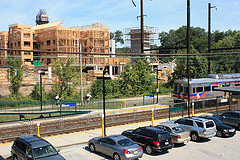
A 2013 analysis of data from Caltrans’ California Household Travel Survey, conducted by TransForm and the California Housing Partnership Corporation, found that “lower-income households drive 25-30 percent fewer miles when living within a 1/2 mile of transit than those living in non-TOD [transit-oriented development] areas.” Living near transit may even enable such households to forgo a car–and the accompanying expenses–altogether. A recent Rooflines post recently discussed how transportation is a more important factor than school quality or crime in helping households escape poverty. . . .
Given the benefits of transit-oriented development to lower-income households, are New Jersey’s transit-hosting municipalities making it easy for such households to live near transit? A recent New Jersey Future research report, OFF TRACK? An Assessment of Mixed-Income Housing around New Jersey’s Transit, looks into this question, examining all 244 of New Jersey’s transit stations (including rail stations of all types, ferry terminals, and major bus terminals) and assessing the degree to which the distribution of household income within each station’s immediate neighborhood matches up with, or departs from, the distribution of household income in the larger region in which the station is located.
The results are mixed. Some station neighborhoods, mainly in the state’s largest urban areas, have so far been unable to capitalize on the renewed demand for walkable, mixed-use, transit-accessible living that has resurfaced in the wake of the Great Recession and remain stubbornly characterized by chronic disinvestment and concentrated poverty. In almost every case, a high concentration of households at the low end of the income spectrum is accompanied by a scarcity of households at the high end; in fact, upper-income households in generally lower-income station areas are more uniformly rare than are lower-income households in more upper-income station areas. The challenge here, as it has been for decades, is how to entice middle- and upper-income households to move into long-distressed places, while not displacing long-time residents.
Of perhaps more immediate interest to housing advocates are the stations whose neighborhoods are dominated by households earning at least double the regional median household income, particularly because most of these higher-income station areas also host a higher percentage of single-family detached housing units than the statewide percentage. From a regional equity standpoint, a housing supply skewed toward single-family detached units, which are generally more expensive than other housing types like apartments or townhouses, can price out many households of more modest means, leaving the neighborhood and its mobility opportunities available only to wealthier residents.
Of course, in some of these wealthier places, the shortage of housing options may not be an accident, since, as a recent CityLab article reminds us, “For more than a century, municipalities across the country have crafted zoning ordinances that seek to limit multi-family (read: affordable) housing within city limits.” This exclusionary zoning is particularly tragic in TOD neighborhoods, in light of the outsized role that transportation plays in the fortunes of lower-income households. But the recent New Jersey State Supreme Court decision removing jurisdiction over affordable housing from the Council on Affordable Housing (COAH) and throwing it back to the courts may present a new opportunity to create housing diversity in places that have lacked it in the past. With municipalities uncertain how the courts will decide to define compliance, many will be looking to get out ahead of potential lawsuits. Promoting mixed-income development or redevelopment projects near transit stations is a good way for transit-hosting municipalities to help satisfy their affordable housing requirements while simultaneously creating transportation options for the types of households that need them most.
(Photo credit: 'Spring Mill TOD' by the Montgomery County Planning Commission, CC BY-SA 2.0)





Comments